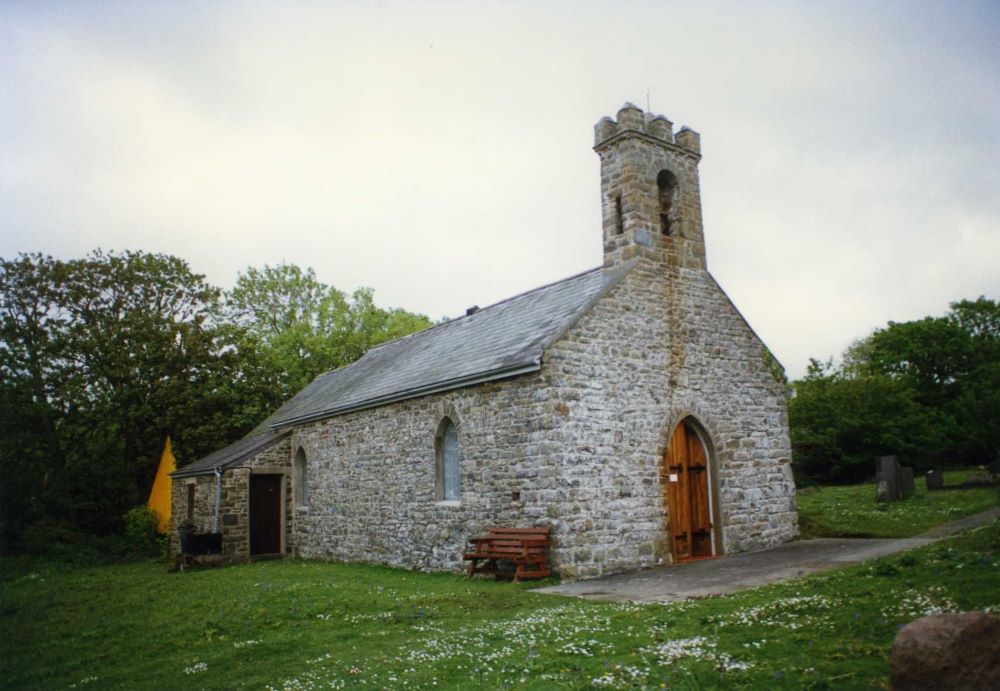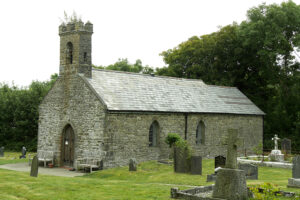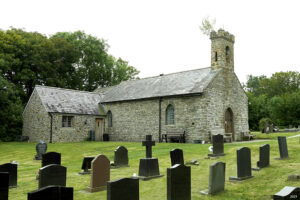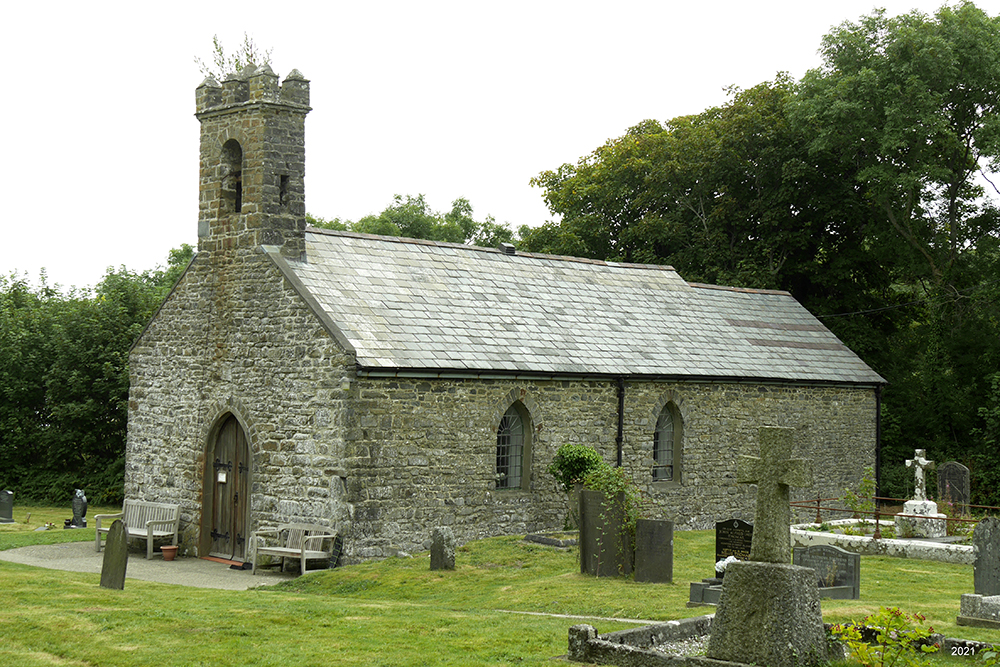


ST INA, LLANINA, CEREDIGION
Dyfed PRN 5656
RB No. 3468
NGR SN 405 598
Listed Building no. 10678
Grade II listed (1998)
First Listed in 1964. Last Amended in 1993.
Reasons for Listing: No Reasons Given
SUMMARY
19th century church; 0% pre-19th century core fabric. On site of, and in same location as, medieval church (Dyfed PRN 8297).
A 2-cell church, small. Consists of chancel, 1 bays; nave, 3 bays; c.1810. Vestry (north of chancel), 1 bays; 1905. Construction is in local rubble. Slate gable roofs; vestry with slate lean-to roof. Openings mainly from c.1810 and neo-gothic, without dressings; western crenellated single bell-turret, largely 1850.
Roofs: 1850?. Floors: 1905. Finishes: 1850 and 1905.
Condition – good..
Archaeological potential – good. Shallow external drain around 100% of church; no underfloor void?.
Structural value (pre 19th century) – poor. 0% pre 19th century core fabric.
Group value – medium. Landmark shoreline location; C19 lych-gate.
Phasing:
Phase 1 – Chancel, nave, c.1810.
Phase 2 – Vestry, 1905. (2021 Note: Vestry has been enlarged since 1998?)
DESCRIPTION
St Ina, Llanina, is a 2-celled church, of small size. It was rebuilt c.1810 on the same site, and in the same location as its predecessor (Dyfed PRN 8297), but nothing was retained from the earlier fabric.
The present church consists of a single-bayed chancel, a 2-bayed nave, and a single-bayed vestry north of the chancel. Construction is in local rubble throughout. Openings, except in the vestry, are neo-gothic but without dressings; the windows are simple single lights which, with the west door, are from c.1810. There is a rectangular, crenellated simple bell-turret at the west end, with a single opening, largely from 1850. The roofs are slated gables, while the vestry has a slated lean-to roof.
The form of the pre-19th century church is not known. It had been ‘newly erected’ in 1810 (Crossley and Ridgway, 1946, 54) and was described as ‘a neat edifice’ (Lewis, 1833). The present plan, with the exception of the vestry, is shown on the tithe map of 1840 (NLW, Llanina, 1837).
It was ‘rebuilt’ again in 1850-55 (Anon., n.d.; Cadw, 1996, 5; Crossley and Ridgway, 1946, 54) but this time the rebuild was only partial. The existing openings were retained, and the work may have been confined to reroofing the church and rebuilding the bell-turret.
It was restored in 1905 (Anon., n.d.) when the vestry was built and the present ceilings, floors and seating were inserted.
A beam from a late 15th – early 16th century rood-screen lies over the west end of the nave; it is not in situ but may have been derived from the medieval Llanina Church during the rebuild of c.1810 (Anon., 1915, 42; Crossley and Ridgway, 1946, 54).
The octagonal font is weathered but still exhibits arcaded decoration; it may be 13th century and has been described as ‘one of the earliest arcaded fonts in Wales’ (Barnwell, 1880, 216).
A shallow external drain surrounds the church. There may be no underfloor void. No external memorials lie significantly close to all walls.
The church was Grade II listed in 1998.
First Listed in 1964. Last Amended in 1993.
SITE HISTORY
There is some evidence for the pre-conquest religious use of the site:-
Celtic dedication; shoreline location.
St Ina, Llanina, was not a parish church during the medieval period (Rees, 1932), but a chapelry of Llanarth parish in the medieval Deanery of Sub-Aeron. With Llanarth, it was appropriated to St Davids Cathedral (Anon., 1863, 264).
Llanina had become a parish by 1833 but the living, a perpetual curacy, was annexed to the vicarage of Llanarth (Lewis, 1833), with which it remained linked until 1979 (Anon., n.d.); the parish defrayed a portion of the expenses of Llanllwchaearn parish (Lewis, 1833).
In 1998 St Ina, Llanina, was a parish church. The living was a vicarage, held with Llanllwchaearn (Benefice 679) in the Archdeaconry of Cardigan, Rural Deanery of Glyn Aeron (St Davids, 1997-8).
The church is dedicated to a local St Ina, not to King Ina of Wessex as has been traditionally accepted (Various, 1994, 392).
SOURCES CONSULTED
Map Evidence
Blaeu, J., 1648, Map of Cardiganshire.
NLW, Ordnance Survey 1:2500, Second Edition, Sheet XXIV.2.
NLW, Parish of Llanina, Tithe Map, 1837.
Rees, W., 1932, South Wales and the Border in the XIVth century.
Church in Wales Records
Hook, Mason, 1993, Quinquennial Report, Llanina.
St Davids, 1997-8, Diocesan Year Book.
Printed Accounts
Anon., n.d., St Ina’s Church, Llanina.
Anon., 1863, ‘Inscribed Stone at Llanarth’, Archaeol. Cambrensis Vol. IX, Third Series.
Anon., 1915, ‘Carved Work in Cardiganshire Churches’, Transactions of the Cardiganshire Antiquarian Society Vol. II.
Barnwell, E. L., 1880, ‘Welsh Fonts’, Archaeol. Cambrensis Vol. XI, Fourth Series.
Cadw, 1996, Buildings of Special Architectural Interest (Llanllwchaiarn, Ceredigion).
Crossley, F. H., and Ridgway, M. H., 1946, ‘Screens, Lofts and Stalls situated in Wales and Monmouthshire: Part 8’, Archaeol. Cambrensis, Vol. XCVIII.
Lewis, S., 1833, A Topographical Dictionary of Wales.
Salter, M., 1994, The Old Parish Churches of South West Wales.
Various, 1994, ‘The Church in Ceredigion in the Early Middle Ages’, in Davies, J. L., and Kirby, D. P. (eds.), Cardiganshire County History Vol. I.
Up dated: September 2021 – PKR


